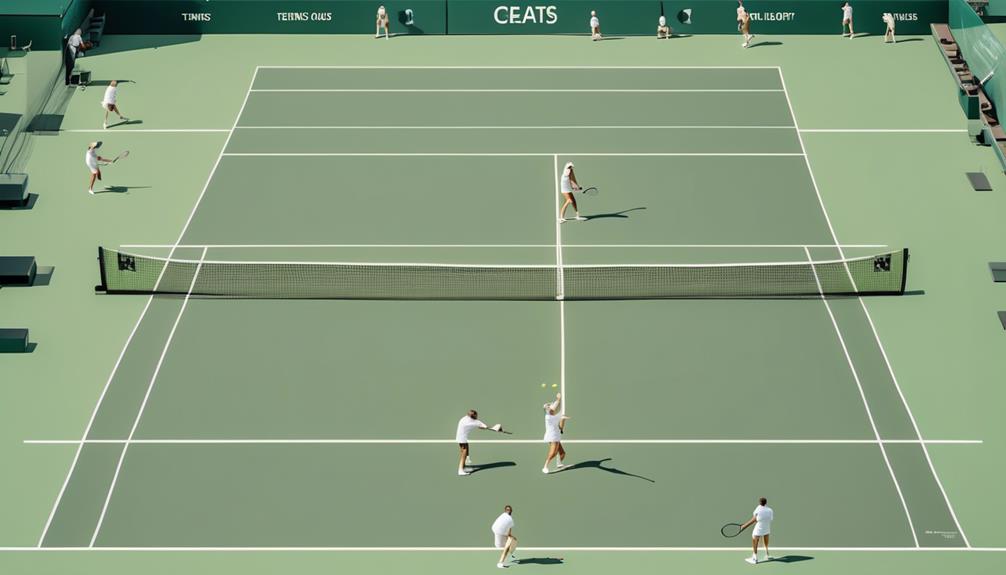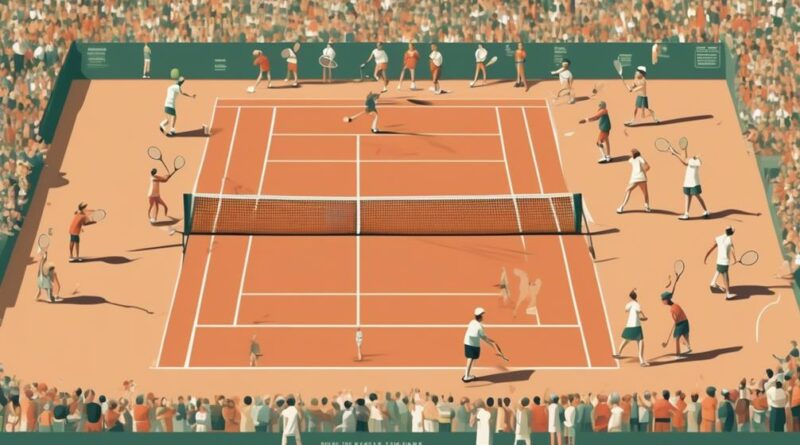6 Tips: Understanding Tennis Rule Changes Through History
You may not realize that the rules of tennis have undergone significant changes over the years, shaping the game into what it is today.
From the early origins of the sport to the introduction of tiebreakers and the influence of technology, the evolution of tennis rules has been a fascinating journey.
As you consider the strategies and techniques used in modern tennis, it's important to understand how historical rule changes have shaped the way the game is played.
This exploration will provide valuable insights into the sport's development and the impact of rule modifications on the overall tennis experience.
Early Origins of Tennis
The early origins of tennis can be traced back to the 12th century in France, where it was played in a form similar to the modern game. Initially, tennis was played by hitting the ball with the palm of the hand, but soon players began using a glove. This eventually evolved into using a handle, creating the first tennis racket. The court design also underwent changes from the narrow, indoor courts of the past to the standardized outdoor courts used today.
Early players of tennis used simple equipment, with rackets made of wood and strings of animal gut. Over time, this evolved into the modern rackets we see today, made from advanced materials such as graphite and titanium, and strung with synthetic materials. These changes haven't only improved the durability and performance of the rackets but have also influenced the style of play.
In terms of court design, the early tennis courts were quite different from the ones we see today. Originally, they were much shorter and played against walls, but as the game evolved, the court dimensions were standardized. Today, tennis courts are rectangular with a net running across the middle, creating separate playing areas for each player.
Understanding the origins and equipment evolution of tennis provides insight into how the game has developed over the centuries, shaping the sport into what it's today.
The Birth of Modern Tennis
As modern tennis began to take shape, advancements in equipment and changes in court design ushered in a new era for the sport. The modern game of tennis has evolved significantly from its origins. The introduction of the lawn tennis game in the mid-19th century marked a turning point in the sport's evolution. This new version of tennis adopted a rectangular court and a net, setting the stage for the modern game. Additionally, the development of more durable rackets and the standardization of tennis balls contributed to the evolution of the sport.
The birth of modern tennis also saw the establishment of formalized rules and regulations. This provided a framework for fair play and consistency across matches, laying the foundation for the structured game we know today. The evolution of tennis has also been shaped by changes in playing surfaces, from grass to clay to hard courts, each requiring different strategies and skills.
Furthermore, the professionalization of tennis, with the formation of international tournaments and governing bodies, has propelled the sport to new heights. The birth of modern tennis brought about a more competitive and globalized game, attracting a diverse range of players and fans. These changes haven't only transformed the way tennis is played but have also enhanced its appeal as a spectator sport.
Major Rule Changes in the 19th Century

During the 19th century, significant modifications to tennis rules shaped the game's trajectory and player experience. This era marked several 19th century innovations and rule adjustments that laid the groundwork for modern tennis.
One of the most impactful changes was the transition from the traditional 'jeu de paume' style of play to the use of rackets. This shift not only transformed the way the game was played but also influenced the rules and strategies involved.
The introduction of the service box in 1874 also had a profound impact on the game, adding depth and complexity to serving techniques and positioning on the court.
Furthermore, the 19th century saw the standardization of the court dimensions and the net height, bringing uniformity to the game and ensuring fair play across different locations. Additionally, the adoption of the first official rulebook in 1877 by the All England Croquet Club (which later became the All England Lawn Tennis and Croquet Club) provided a comprehensive set of guidelines for the sport, further solidifying its structure and regulations.
These rule changes not only shaped the way tennis was played during the 19th century but also set the stage for the evolution of the game in the years to come. By embracing innovation and making necessary adjustments, tennis was able to adapt to the changing times and continue to captivate players and fans alike.
Impact of Wimbledon on Tennis Rules
Wimbledon's influence on tennis rules can be seen in the evolution of serving techniques and court positioning.
Wimbledon, as the oldest tennis tournament in the world, has a rich history and holds a special place in the sport. The tournament's traditions have had a significant impact on the development and adaptation of tennis rules over time.
One of the most notable impacts of Wimbledon's traditions on tennis rules is the rule adaptations related to serving techniques. Wimbledon's grass courts have historically influenced players to develop specific serving strategies. This has led to rule changes regarding the height and placement of serves, ensuring that the game remains fair and competitive across different court surfaces.
Additionally, Wimbledon's emphasis on court positioning and movement has influenced rule changes related to player conduct and positioning during matches. The tournament's traditional style of play, with its focus on finesse and strategic court coverage, has prompted adaptations in rules related to player movement, footwork, and positioning on the court.
Furthermore, Wimbledon's commitment to upholding the integrity and sportsmanship of the game has influenced rule changes related to player behavior and etiquette on the court. The tournament's emphasis on respectful conduct and adherence to the rules has contributed to the development of regulations that govern player behavior during matches.
Evolution of Scoring Systems
The impact of Wimbledon's traditions on tennis rules has extended to the evolution of scoring systems, reflecting the tournament's influence on the entire structure of the game. Over the years, scoring innovations have been introduced to enhance the sport's appeal and competitiveness, with historical context shedding light on the rationale behind these changes.
- Introduction of Tiebreakers: In the 1970s, tiebreakers were introduced to prevent prolonged matches, providing a clear and exciting way to conclude sets that were tied at 6-6. This innovation revolutionized the game, adding an element of suspense and ensuring that matches remained engaging for players and spectators alike.
- Adoption of No-Ad Scoring: The concept of no-ad scoring was implemented in certain tournaments, simplifying the scoring system and reducing the length of matches. With this system, the first player to win four points wins the game, eliminating the need to win by a two-point margin. This change aimed to quicken the pace of matches and make them more dynamic.
- Introduction of Match Tiebreakers: In an effort to add excitement and reduce the uncertainty of lengthy final sets, the match tiebreaker was introduced. This format, often used in doubles matches, allows for a decisive outcome by requiring the first team to reach 10 points with a two-point advantage, effectively avoiding prolonged matches without compromising on competitiveness.
These scoring innovations, implemented within a specific historical context, exemplify the sport's adaptability to meet the evolving needs of players and fans while preserving the essential elements of tennis.
Introduction of Tiebreakers
The introduction of tiebreakers in tennis revolutionized the game by providing a clear and exciting way to conclude sets that were tied at 6-6. This scoring innovation was a game-changer, as it eliminated the need for potentially endless sets and added a new level of tension and strategy to matches.
Before the introduction of tiebreakers, matches could become drawn-out affairs, especially in the case of closely contested sets. This had a significant impact on match dynamics, often leading to fatigue and affecting the overall flow of the game.
Tiebreakers were first introduced in the early 1970s, and they quickly gained popularity for their ability to add drama and intensity to matches. The format of the tiebreaker varies slightly across different tennis tournaments, but the fundamental principle remains the same – to provide a clear and decisive way to conclude a set that's deadlocked at 6-6. This innovation not only brought more excitement to the sport but also had practical implications, allowing for more efficient scheduling of matches and preventing them from running excessively long.
The introduction of tiebreakers marked a significant milestone in the evolution of tennis rules and regulations. It not only addressed the issue of prolonged sets but also fundamentally changed the way players approached and strategized around tied sets. This change in match dynamics continues to shape the modern game of tennis, adding an element of unpredictability and excitement for players and fans alike.
Influence of Technology on Tennis Rules

The introduction of tiebreakers in the 1970s brought significant changes to the game, and today, the influence of technology on tennis rules continues to shape and redefine the sport's dynamics at all levels. Technology advancements have revolutionized the way tennis is played and officiated, enhancing the accuracy and fairness of the game.
Here's how technology is influencing tennis rules:
- Hawk-Eye and Electronic Line Calling: The introduction of electronic line calling technology, such as Hawk-Eye, has greatly impacted the enforcement of rules in tennis. This innovation allows players to challenge calls with precision, leading to more accurate line calls and reducing human errors in officiating.
- Rule Enforcement and Instant Replay: Technology has enabled instant replay capabilities, allowing officials to review contentious points and make more accurate decisions. This has significantly improved rule enforcement and has minimized potential disputes between players and officials.
- Data Analysis for Rule Adjustments: Advancements in data analysis have provided insights into player performance, leading to potential adjustments in tennis rules. By analyzing player statistics and match data, governing bodies can make informed decisions about rule changes to enhance the competitiveness and fairness of the sport.
Contemporary Rule Changes and Their Impact
Exploring the impact of contemporary rule changes on the game of tennis reveals the evolving dynamics and challenges faced by players and officials alike.
Player conduct has been a focal point for recent rule changes, with stricter enforcement of codes of conduct to maintain the integrity and sportsmanship of the game. This has led to a more respectful and professional environment on the court, enhancing the overall experience for players and spectators.
In addition, equipment regulations have undergone significant changes in recent years. Technological advancements have necessitated a closer look at the equipment used in the game to ensure fairness and safety. The implementation of new regulations regarding racket technology, string materials, and ball specifications has aimed to maintain a balance between skill and equipment advantages, ultimately impacting the way the game is played at both amateur and professional levels.
These contemporary rule changes have had a profound impact on the game of tennis. Players aren't only expected to demonstrate exceptional skill and athleticism but also to adhere to higher standards of conduct. Similarly, equipment regulations have forced players to adapt to new standards, influencing the strategies and tactics employed on the court.
As the sport continues to evolve, it's crucial for players and officials to remain adaptable and open to further changes that uphold the integrity and competitiveness of tennis.
Frequently Asked Questions
How Do Tennis Rule Changes Compare to Other Sports' Rule Changes Throughout History?
When comparing historical context, the evolution of sports rules in tennis differs from other sports. Rule changes in tennis have often focused on maintaining tradition, while other sports have adapted more radically to modern trends.
What Role Did Gender Equality Play in the Evolution of Tennis Rules?
In the evolution of tennis rules, gender equality has played a significant role. Historical context reveals the progression towards fair treatment and opportunities for both male and female players, shaping the rules in modern tennis.
How Have Rule Changes Affected the Strategy and Tactics Used by Professional Tennis Players?
Rule changes in tennis have impacted gameplay, forcing players to adapt. This has led to an evolution in strategy and tactical adjustments. Understanding how these changes affect the game can give you an edge on the court.
What Impact Have Rule Changes Had on the Overall Fan Experience and Viewership of Tennis Matches?
Rule changes in tennis have had a significant impact on fan engagement and viewership. Understanding the rule implications can enhance the overall experience for fans, as it adds excitement and unpredictability to matches.
Are There Any Controversial Rule Changes That Have Sparked Debate and Discussion Within the Tennis Community?
Controversial changes in tennis rules have sparked heated debate within the community. Player perspectives on issues like shot clock implementation and coaching violations vary widely, leading to intense discussions and disagreements among fans and players alike.
Conclusion
So, now you understand how tennis rules have evolved over time.
From the early origins to the influence of major tournaments like Wimbledon, and the impact of technology, tennis rules have constantly changed.
The introduction of tiebreakers and the evolution of scoring systems have also shaped the game we know today.
Keep these tips in mind as you continue to follow the sport and watch for future rule changes.
